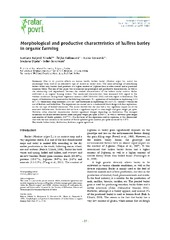| dc.creator | Roljević-Nikolić, Svetlana | |
| dc.creator | Dolijanović, Željko | |
| dc.creator | Kovačević, Dušan | |
| dc.creator | Oljača, Snežana | |
| dc.creator | Šeremešić, Srđan | |
| dc.date.accessioned | 2021-06-23T10:39:45Z | |
| dc.date.available | 2021-06-23T10:39:45Z | |
| dc.date.issued | 2021 | |
| dc.identifier.issn | 1821-3944 | |
| dc.identifier.uri | http://aspace.agrif.bg.ac.rs/handle/123456789/5866 | |
| dc.description.abstract | Due to its positive effects on human health, hulless barley (Hordeum vulgare var. nudum) has increasingly been used as an alternative type of cereals in recent years. The main advantage of introducing hulless barley into various food products is a higher content of β-glucan than in other cereals and in particular common wheat. The aim of this paper was to examine morphological and productive characteristics, as well as the relationship and dependence between the studied characteristics of the hulless barley cultivar Goliat cultivated in an organic farming system. The mentioned characteristics were examined with regard to the weather conditions during three vegetation seasons (2009/2010-2011/2012) and with regard to fertilization. The impact of fertilization was monitored in the following treatments: T1 - application of biofertilizer in topdressing (5.0 l ha-1); T2- fertilization using biohumus (3.0 t ha-1) and biofertilizer in topdressing (5.0 l ha-1); T0 - control - without the use of fertilizer and biofertilizer. The experiment was carried out in a randomized block design with four replications, on the soil type of leached chernozem. The results showed that the year had a very significant impact on all the examined characteristics. Fertilization did not have a significant impact on stem length and grain weight per spike. However, other observed characteristics showed significant changes depending on fertilization. The strongest correlation was found between harvest index and grain weight per spike (0.898**), as well as between spike length and number of fertile spikelets (0.877**). On the basis of the regression analysis equation, it was determined that with the unit increase in the number of fertile spikelets grain number per spike increased by 0.573. | sr |
| dc.language.iso | en | sr |
| dc.publisher | Institute of Field and Vegetable Crops | sr |
| dc.relation | info:eu-repo/grantAgreement/MESTD/Integrated and Interdisciplinary Research (IIR or III)/46006/RS// | sr |
| dc.rights | openAccess | sr |
| dc.rights.uri | https://creativecommons.org/licenses/by/4.0/ | |
| dc.source | Ratarstvo i Povrtarstvo | sr |
| dc.subject | Fertilization | sr |
| dc.subject | Fertilizers | sr |
| dc.subject | Hulless barley | sr |
| dc.subject | Organic agriculture | sr |
| dc.title | Morphological and productive characteristics of hulless barley in organic farming [Morfološke i produktivne osobine golozrnog ječma u uslovima organske proizvodnje] | sr |
| dc.type | article | sr |
| dc.rights.license | BY | sr |
| dc.citation.epage | 34 | |
| dc.citation.issue | 1 | |
| dc.citation.rank | M24 | |
| dc.citation.spage | 27 | |
| dc.citation.volume | 57 | |
| dc.identifier.doi | 10.5937/ratpov57-24808 | |
| dc.identifier.fulltext | http://aspace.agrif.bg.ac.rs/bitstream/id/23055/Morphological_and_productive_pub_2021.pdf | |
| dc.identifier.scopus | 2-s2.0-85106637258 | |
| dc.type.version | publishedVersion | sr |


